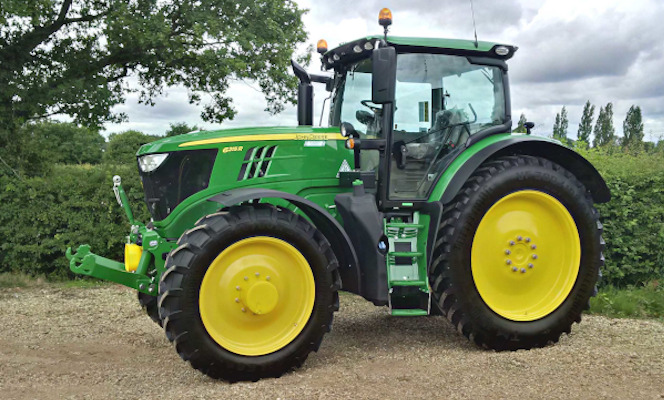Contents:
What are VF tyres?
Comparing standard, IF & VF tyres
Top reasons to use VF tyres
Real world examples
History of VF tyres
Which manufacturers make VF tyres?
What are VF tractor tyres?
VF is used to identify an agricultural tyre that can either:
Carry the same load as a standard tyre in the same size, but at 40% lower pressure
…or…
Carry 40% more load than a standard tyre in the same size, at the same pressure
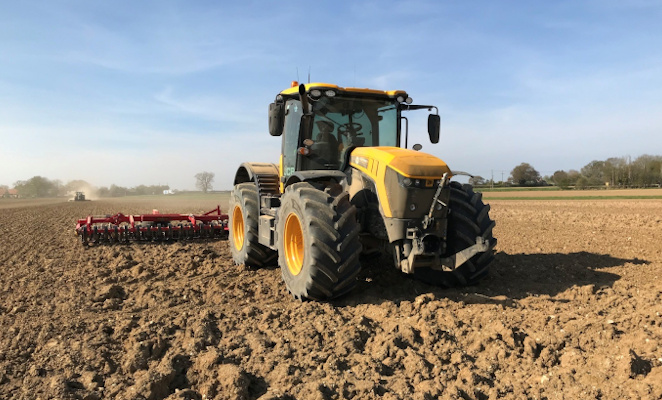
Ag tyres can be separated into 3 categories: Standard, IF and VF.
IF stands for Increased Flexion.
VF stands for Very-High Flexion.
Standard tyres have nothing before the size (e.g. 650/65R38) and IF tyres have an “IF” (e.g. IF 650/65R38).
If a tyre is a VF tyre, it will have a ‘VF’ in front of the tyre size. For example: VF 650/65R38.
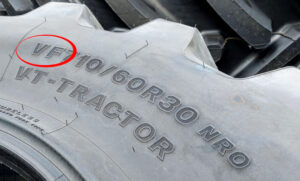
Studies have found that with most agricultural rotations (except Controlled Traffic Farming), more than 70% of the field is driven on. It has also been proven that 85-90% of the compaction is caused on the first pass.
When you consider how much of your field is affected by your tyres, it shows the importance of choosing the correct tyre and tyre pressure for your machines.
Comparing Standard, IF & VF tyres - Overview
Standard
e.g. 650/65R38
This is the standard and most common type of tyre.
IF Tyre
e.g. IF 650/65R38
Improves tyre performance by:
20%
VF Tyre
e.g. VF 650/65R38
Improves tyre performance by:
40%
Comparing Standard, IF & VF 650/65R38 tyres
Standard
e.g. 650/65R38
This is the standard and most common type of tyre.
IF Tyre
e.g. IF 650/65R38
Compared to a standard tyre an IF tyre will:
Will carry 20% more weight at the same pressure
or
Will carry the same weight at 20% lower pressure
VF Tyre
e.g. VF 650/65R38
Compared to a standard tyre a VF tyre will:
Will carry 40% more weight at the same pressure
or
Will carry the same weight at 40% lower pressure
Standard, IF & VF tyre pressures:
650/65R38: Will carry 4.1 ton @ 23 psi/1.6 bar
IF 650/65R38: Will carry 4.1 ton @ 17 psi/1.2 bar
VF 650/65R38: Will carry 4.3 ton @ 14 psi/1 bar
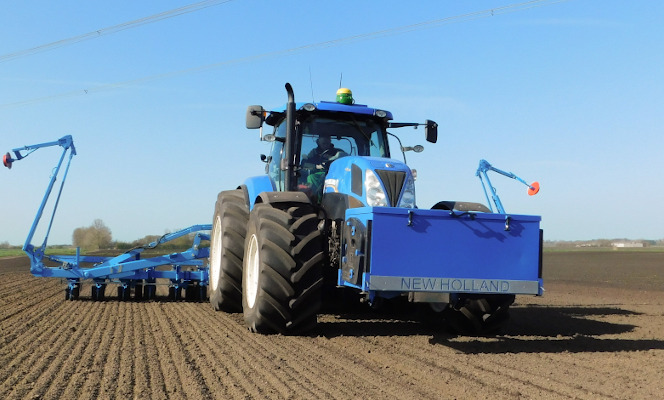
The Top 5 reasons to use VF tyres?
Why are farmers and contractors swapping to VF tyres? There are a few reasons:
1. VF tyres increased yields by up to 4%
A 2014/2016 study by Harper Adams University (using Michelin Ultraflex tyres) found that farmers solely using low pressure tyres could increase their total yields by up to 4%.
Once the initial cost of the VF tyres is paid off, the extra yield gained is extra profit – it goes straight onto the bottom line.
The study says that if all agricultural vehicles in the main wheat-growing areas of the world used Ultraflex tyres, an extra 23 million tonnes of wheat would be produced each year. 23 million tons is enough to feed the entire population of the United States for a whole year – over 300 million people. 23 million tonnes is more than double the UK’s wheat production.
2. VF tyres reduce soil compaction
In summary soil compaction can lead to:
- Reduced crop yield – Poor root growth due to poor water and nutrient uptake as well as poor germination in compacted soils
- Extra fuel costs – through extra work needed for cultivating and seedbed preparation
- Decreased water absorption and increased runoff/soil erosion
- Decreased fertiliser efficiency – compacted soil provides less suitable soil to retain and release fertiliser needed for crop growth.
Soil compaction occurs when soil particles are pressed together, reducing pore space between them.
Soil compaction can cost you between £600/ha and £1,200/ha, explains John Williams, principal scientist at independent crop research firm Adas – which quickly eats into your farm’s profit. Significant compaction can reduce soil productivity by 30% to 40%.
Soil compaction - Key Information
There are 3 types of compaction:
- Topsoil compaction (Approx. 0-30cm deep) – which is directly attributable to the tyre contact pressure
- Upper subsoil compaction (Approx. 30-50cm deep) – due partly to tyre contact pressure and partly to axle load pressure
- Lower subsoil compaction (Approx. 50cm and deeper) – Directly attributable to the weight on the axle
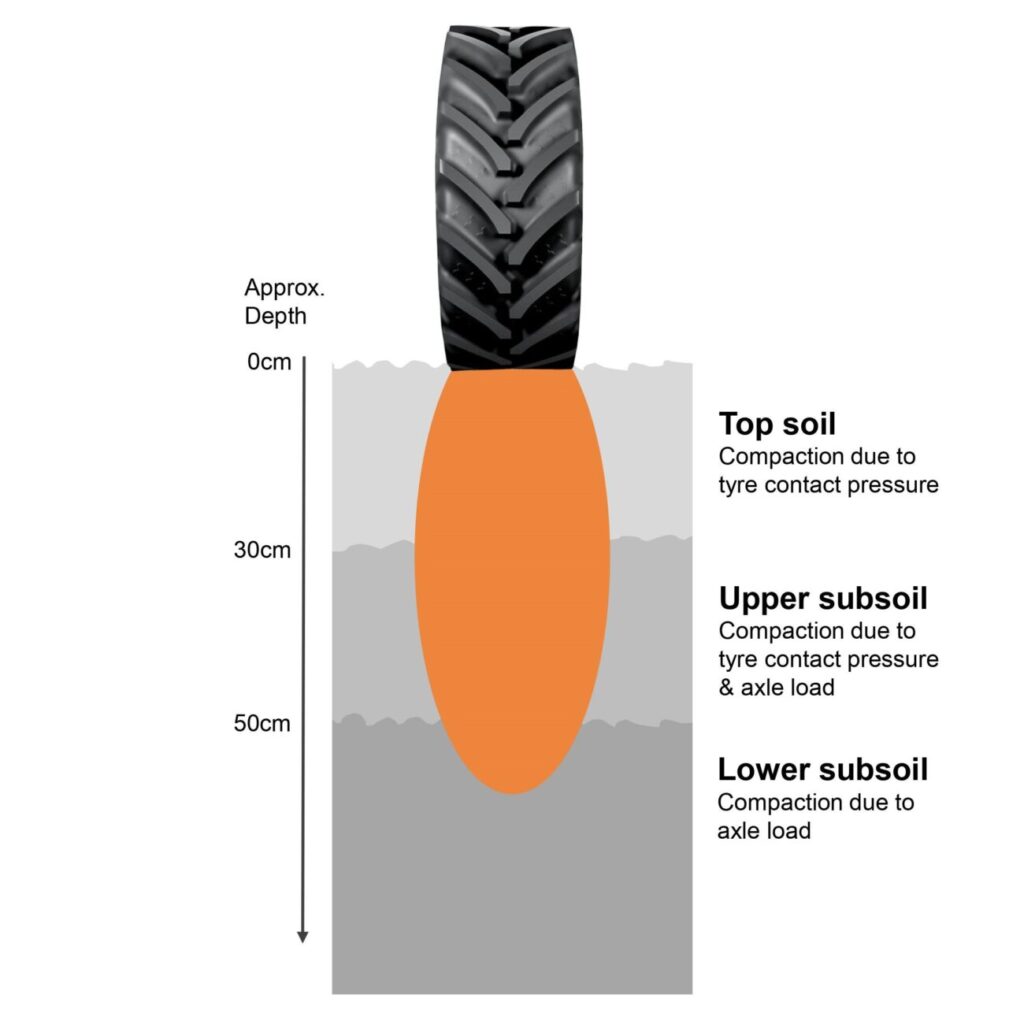
Surface compaction (top soil) causes the biggest negative impact on yields. Deep compaction causes less yield reduction, however is very long lasting – with studies showing 10% yield reduction even 12 years after the initial deep compaction, even though no further compaction occurred (Ohio State University).
While reducing axle load and improving subsoil compaction is very important, VF tyres help reduce topsoil and upper subsoil compaction by allowing you to carry the weight you need at a much lower tyre contact pressure.
Continued…VF tyres reduce soil compaction
So for now, we will focus on top soil compaction and how VF tyres help reduce this.
While there are too many variables to say an exact pressure your soil will be compacted at, we know two things:
- The lower the pressure, the less the compaction.
- Studies show that soil compaction occurs above 15psi/1bar of pressure. (Although roots struggle to grow in ground pressure 10psi or above)
Important Note: As a rule of thumb, the pressure on the ground is approx. 2 psi higher than the air pressure in the tyre. I.e. 14psi in the tyre is likely to be 16psi on the ground.
So as a general rule the lower the tyre pressure the better – with anything below 15psi/1bar being good.
To be able to operate with any real load carrying capacity and standard speeds you need VF tyres.
Standard Michelin MachXbib 900/50R42 tyres running at 65kmh would only carry 3,550kg per tyre at 13 psi/0.8 bar. By comparison, VF 900/50R42 Bridgestone tyres will carry 5,305kg per tyre at the same pressure and speed.
VF tyres mean you can run at very low pressures to minimise top soil compaction, while still having enough weight carrying capacity.
3. VF tyres increase traction
By being able to reduce the pressures, VF tyres increase your traction. A Michelin study (Boulogne-Billancourt, 2014) showed VF tyres delivered 7% more torque than a standard tyre.
We don’t have traction data comparing VF tyres to standard tyres, but have managed to find some data to help back up the claim that lower pressure tyres increase traction:
Michelin compared 710/70R42 Michelin MachXbib tyres to IF 710/70R42 Michelin Axiobib tyres and concluded that the IF tyre gave +11% more traction. (Reminder, IF tyres can run at 20% lower pressure, VF tyres at 40% lower pressure)
A Bridgestone study (Bernburg, March 2014) tested IF 600/70R30 & IF 710/70R42 in two different makes of tyre against the VF 600/70R30 & VF 710/70R42 Bridgestone. Bridgestone found that the VF tyres could cover on average 0.55ha more in a day with the same equipment (+0.9ha compared to one competing brand & +0.2ha compared to a different competing brand)
At the expense of soil compaction – VF tyres also allow you to increase the weight on the axle to increase ballast for better traction.
The correct pressure pays!
These pictures from a Bridgestone training day in Scotland show the importance of correct tyre pressures when cultivating.
Two John Deere 6155Rs fitted with identical Bridgestone VT-Tractor tyres, both pulling an identical Kuhn Cultivator.
The left-hand tractor was running at 10psi, the right-hand tractor at 25psi.
This shows how being able to run at lower pressure increases the traction, reducing fuel usage and soil damage.
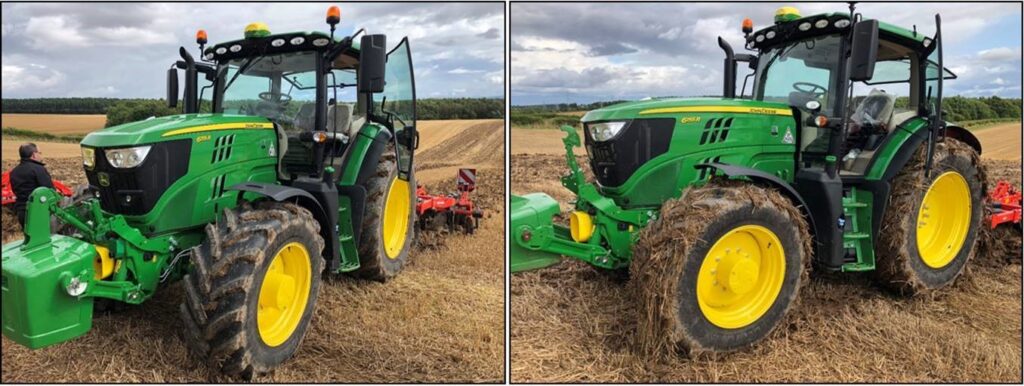
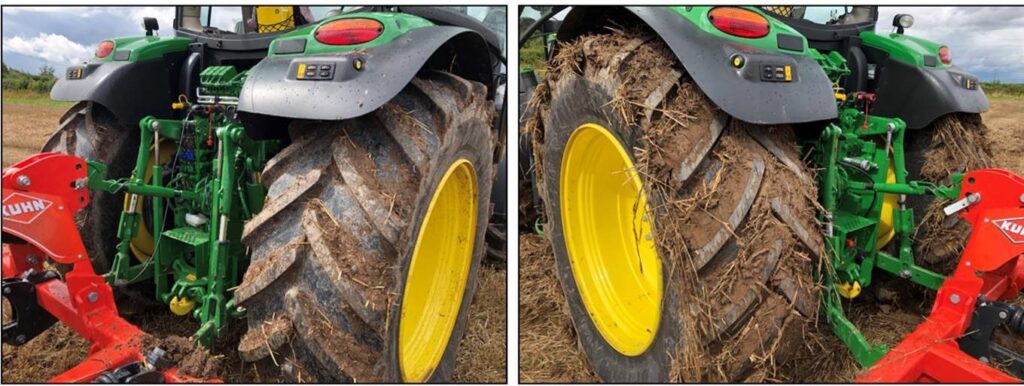
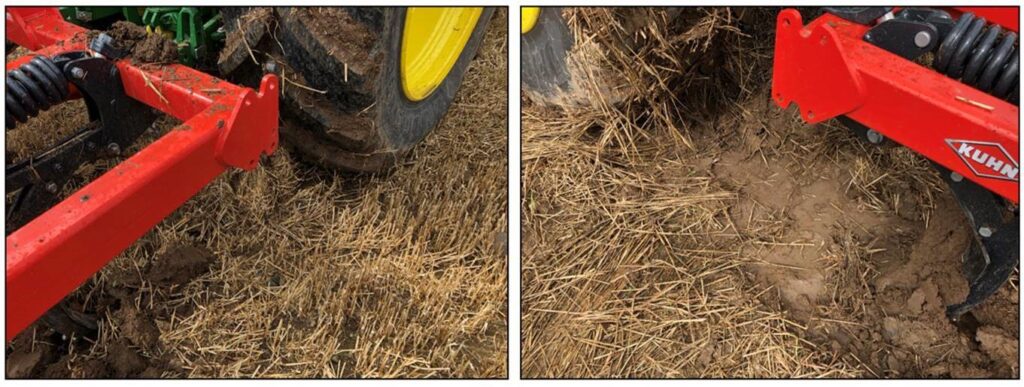
4. VF tyres reduce fuel use
VF tyres reduce fuel use in two main ways.
Firstly, by increasing traction:
A Bridgestone test comparing a VF tyre to an IF tyre found that, thanks to the increased traction, they achieved fuel savings of up to 36 litres per 50ha (123 acres) of heavy draft work.
An Alliance test on the VF 372 Agriflex+ recorded a 7% reduction in fuel consumption compared to an IF tyre.
Secondly, by reducing soil compaction:
VF tyres can run at lower pressure. This reduces soil compaction and therefore removes the need for remedial cultivation.
Compacted soil requires much more horsepower (and fuel) to cultivate, as does increasing the depth of your cultivation. Doubling the depth of your cultivation quadruples the energy required. One study showed that subsoiling after a low-pressure pass of a combine required up to 63% less force to pull.
Less force to pull requires less traction which means less ballast is needed. In rough figures, removing 1ton of unnecessary ballast results in a saving of 1 litre of fuel per hour of use.
Additionally, less rutting improves fuel economy. In the same 2014 Michelin study mentioned above, the ruts left in the soil by the XeoBib were 21mm deep compared with 46mm for the standard tire, representing a 55% reduction in rut depth. When a tyre forms a rut, it is similar to it continually driving up an incline. The deeper the rut the steeper the incline. Therefore, shallower ruts also reduce fuel consumption.
Finally, VF tyres can carry 40% more load than a standard tyre – this could mean less transport cycles on the road (resulting in lower fuel costs).
5. VF tyres save time
VF tyres can run at the same pressure in the field and on the road. While a lot of people don’t do it, standard tyres should be run at lower pressure in the field and higher pressure for road use. Some farmers and contractors will stop to change tyre pressures before entering and leaving the field. This takes time. Time that can be saved with VF tyres as they can run at the same pressure in the field and on the road.
Additionally, VF tyres can carry 40% more load than a standard tyre – this could mean you can do 40% fewer loads as you can safely increase your load weight.
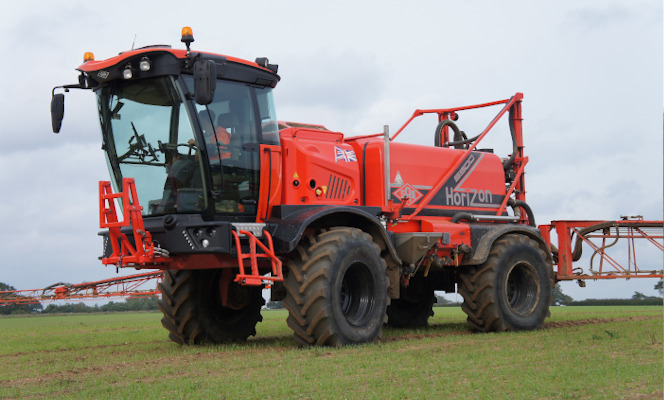
Real World Examples

710 wide wheels, JCB Fastrac 4220
Ed has a new JCB 4220 Stage 5 which has come on 600/70R30 wheels. He really likes the tractor, but it’s a heavy machine for only 600mm wide tyres. He wants to get a set of flotation wheels to do topwork. It’s been a wet year and he wants to keep the compaction and rutting to a minimum.
Looking at the options, we can come up with the following data. Assuming Ed needed to carry 4 ton per tyre he would be able to run at the following pressures:
| Pressure needed to carry 4 ton up to 65kmh | |||
| 710/60R30 Trelleborg | 1.6 bar | 23 psi | 3,945kg |
| 710/60R30 Mitas | 1.6 bar | 23 psi | 4,030kg |
| 750/55R30 Mitas | 1.6 bar | 23 psi | 4,000kg |
| IF 710/60R30 BKT | 1.3 bar | 19 psi | 4,030kg |
| VF 710/60R30 Bridgestone | 1 bar | 15 psi | 4,000kg |
The table shows that the IF BKT can run at approx. 20% lower pressure than the standard tyres, and the VF Bridgestone more than 40% lower.
One interesting point to note is that the 750/55R30, despite it being a wider tyre, actually has a smaller footprint and must be run at 0.6bar/8psi higher pressure than the VF 710/60R30.
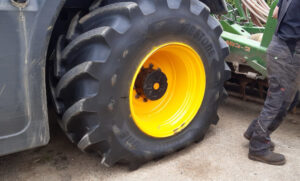
380mm wide rowcrops for a John Deere 6195R
James had a new John Deere 6195R which he intended to use for fert spinning. He has a 3 ton fert spinner and wants to find some rowcrops for the machine. He’s hoping to get a set in a 380mm width. James estimates that the weight of the fert spinner, plus the fert, plus the weight of the tractor means he will have over 9 ton on the rear axle of his machine.
There are two options of 380mm wide rowcrops for the long frame 6R:
- 380/90R54
- VF 380/105R50
For the sake of the example, we’ll compare BKT tyres in both sizes:
- 380/90R54 BKT Agrimax will carry 8.5ton across the back axle
- VF 380/105R50 BKT Spargo will carry 15.5ton across the back axle
Comparing the load ratings we can see that the 380/105R50 is the only option that will take the weight.
Tyre pressure:
Interestingly, the tyre pressures you can run the two tyres at are significantly different.
Say, for example James was only needing to carry 8.5 ton across the back axle.
He would need to run the 380/90R54 BKT’s at 46psi (3.2 bar) just to take the weight.
In comparison, the VF 380/105R50’s can carry the weight at 22psi (1.5 bar)
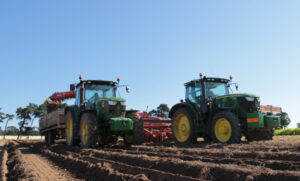
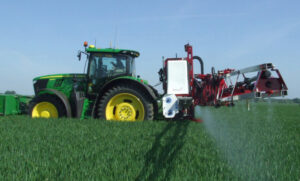
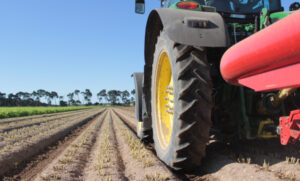
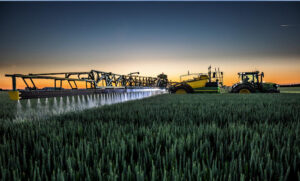
620mm wide wheels for a John Deere trailed sprayer
Stan was needing some intermediary wheels for his John Deere R900i. At an axle weight of 9,200 when full, he needed wheels that would both take the weight and run at lower pressure to avoid damaging his soil. Stan wanted tyres that were around 620mm wide.
Two of the options for Stan were as follows:
Standard Tyre
Standard 620/70R42 BKT RT765, 160A8/B: These would need to run at 1.6bar or 23 psi to carry the weight
VF Tyre
VF 620/70R42 Bridgestone VT-tractor, 172D/169E: These could run at 1 bar / 14psi to carry the weight.
This shows how the VF Bridgestone tyres can carry the same weight at 40% lower pressure.
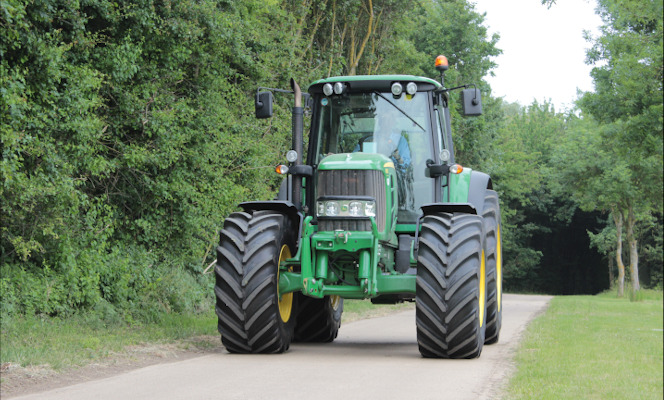
History of VF tyres
Michelin invented the first VF tyre in 2003. By reducing the amount of rubber they used in the sidewall and increasing the amount in the tread area, Michelin found they could make the tyre flex more. This gave the tyre a longer footprint – increasing the contact area, without increasing the tyre width. With this development they introduced the Michelin Xeobib tyre and their UltraFlex technology.
Michelin had an unrivalled reign of the VF tyre market up until 2014 when Bridgestone introduced the VT-Tractor range, followed by Trelleborg launching the TM1060 range the next year.
The Michelin Xeobib range has the 60 profile (e.g. VF 710/60R38, VF 710/60R42, VF 650/60R38). They require wider rims to give the largest footprint and counter the extra stress on the tyre caused by the low pressure. This meant that Xeobib tyres needed specific rims sizes to suit the tyres.
In 2014 Bridgestone introduced the VT-Tractor tyre range. The idea was to produce VF tyres in common sizes, which fit normal sized rims. This meant farmers could replace existing tyres with a VF equivalent or buy VF tyres on rims and fit standard tyres on the same rims later on. The benefit of this is they weren’t stuck buying the more-expensive VF replacement tyres, even if the tractor was downgraded.
It was a major success.
John Deere quickly offered Bridgestone tyres on their tractors and for the first year or so, demand was so high that the tyres were very hard to get hold of. The tyre market was finally seeing a shakeup – one as important as the change from cross-ply to radial tyre technology.
This VF tyre technology and the importance of low tyre pressures was here to stay.
2015 saw Trelleborg launch the TM1060 range – this was a copy of the Michelin Xeobib sizes, but with increased carrying capacity (around 40% higher). This is important because in 2003 when Michelin introduced the Xeobib tyres, we were driving John Deere 6520 and 6620 sized tractors with a tractor weight of about 5 ton. The Xeobib didn’t have the highest load rating.
In its prime, the Michelin Xeobib VF 710/60R38 was the most common option for the Challenger (now Fendt) Rogator sprayers – but they were actually overloaded when fully-loaded. The Trelleborg equivalent had a much higher load rating, making them a better option. Nowadays its more common to go for the larger diameter VF 650/65R42 or VF 650/75R38 and get a larger footprint – more on that here: Fendt Rogator Wheel Options
While it’s not as commonly known, the load rating also determines how much horsepower a tyre is rated to. As the Trelleborg TM1060’s had that higher load rating, they were then rated for tractors up to 300hp (a big increase compared to the Michelin Xeobib).
Since 2015 many tyre manufacturers have been introducing new VF ranges and expanding existing ones – until today where almost all tyre manufacturers have a VF tyre available.
Which manufacturers make VF tyres?
Bridgestone VF Tyres
Bridgestone launched the VT-Tractor tyre range in 2014. They now have a large and complete range of VF tyres for tractors, sprayers and the VT-Combine range for combines. Lots of common sizes, but in VF technology.
They are our go-to brand for VF tyres.
With a 10-year warranty they are a premium product and are good, reliable tyres.
In our opinion, the Bridgestone has the widest range of VF tyres in useful sizes. However, the Bridgestone range does not currently include any VF rowcrop tyres.
Michelin VF Tyres
Michelin started making VF tyres in 2003 with the Xeobib range. Since 2015 when other manufacturers introduced rival products, Michelin have expanded their range considerably.
The Michelin Spraybib is a useful VF tyre range for rowcrop sizes – the VF 380/90R46 size are common OEM fitment on large sprayers such as the Fendt Rogator. The VF 420/95R50 Michelin Spraybib is a useful size for rowcrop work on long frame 6R’s such as the John Deere 6195R-6250R and also Fendt 828’s. We expect to see them sold for the new Massey Ferguson 8S tractors as well.
Michelin have a smaller Yieldbib range of VF rowcrop sizes too.
The Michelin answer to the Bridgestone VT-Tractor is the Axiobib 2 range. This plays on the success of Michelins IF Axiobib range, but with VF technology.
When comparing VF tyres, it’s important to note that the rim size can affect what tyre pressure they should run at. Michelin requires an extra 0.2 bar / 2.9 psi pressure per tyre when using the Narrow Rim Option (NRO). As an example, the VF 650/65R42 Michelin Axiobib is recommended on a 23×42 rim, however this is not a common rim size. Most 650/65R42 tyres are fitted on 20×42 rims – if you’re swapping your standard tyre to VF tyres and chose the Michelin Axiobib 2, you’d need to factor in that extra 0.2 bar / 2.9 psi pressure.
Michelin also have the CerexBib range for combines and the Evobib range which is a special tyre for high intensity road/field operation.
Finally, Michelin have just rolled out the TrailXbib, a VF trailer tyre. This was useful when the Scottish government launched a grant scheme aimed at rewarding farmers for swapping to VF wheels and tyres.
Trelleborg VF Tyres
Trelleborg have VF tyres ranges called the TM1060 and TM150. They also have some VF tyres within the TM1000 HP range
Mitas VF Tyres
Mitas have the HC3000 range designed for harvesters. The HC1000 range contains VF rowcrop tyres and the HC2000 range is a mix of standard size tyres and rowcrop tyres.
BKT VF Tyres
BKT first launched a VF tyre with their VF 380/85R38 size, designed specifically for the JCB Fastrac. With its high load and speed rating, it is still the most common rowcrop size we supply for the 4000 series JCB ‘s.
More recently BKT have brought out the V-Flecto range which is a VF range with useful sizes such as the VF 650/65R38, VF 650/65R42, VF 710/60R38. These provide a great budget VF tyre option.
BKT is currently the only budget VF tyre with a complete range of tyre sizes. They are now often used on sprayers and tractors and are very popular alternatives to the premium alternatives. BKT are continually bringing out more sizes expanding their range of VF tyres. considerably faster than any other tyre manufacturer.
BKT also make a V-Flexa tyre range, an alternative VF trailer tyre to the Michelin TrailXbib.
Alliance VF Tyres
Alliance have a number of VF tyres in their ranges including the 354, 375, 372, 363 and 365 ranges, as well as the Alliance 389 trailer tyre range.
Ceat VF Tyres
The reputable Indian tyre manufacturer Ceat has a VF range called the Ceat Torquemax but this is currently available in only two sizes.
Vredestein VF Tyres
Vredestein has a VF range called the Traxion Optimal VF.
Continental VF Tyres
The Continental brand relaunched and in 2020 introduced a whole new range of tyres. This includes two VF tyre models: the VF TractorMaster and VF CombineMaster

